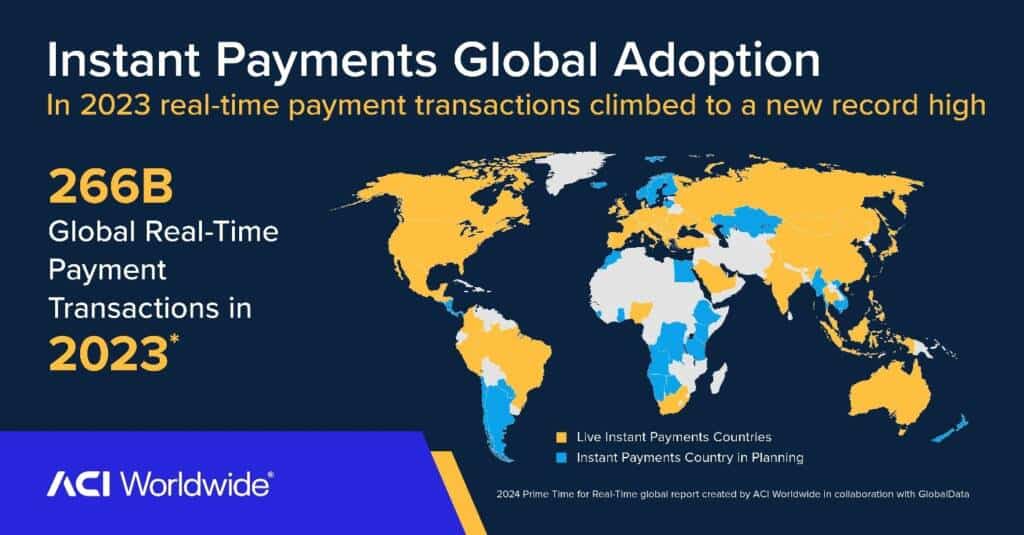On This Page
The real-time payments reality
Real-time payments are carving a new norm in the rapidly evolving payments landscape. Spurred by global governments and regulators, instant payments are viewed as a catalyst for economic growth, financial inclusivity, and transparency. According to ACI Worldwide’s 2024 Prime Time for Real-Time report, this trend is not merely a temporary surge but a shift toward sustainable growth as early adopters mature. In 2023, real-time payment transactions hit 266 billion, a 42% YoY increase from 2022. By 2028, the report predicts global real-time payment transactions will reach an impressive 575 billion.

In tandem with the real-time revolution, consumer behavior has transformed. The digital age has sparked consumer preference for immediate, mobile-based transactions. This shift is most pronounced in high mobile wallet usage markets, where consumers are progressively opting for real-time payments. Primarily, with the historical reliance on cash transactions in these markets, mobile payments are emerging as a channel for increased digital transactions. The report makes the connection that there is a strong correlation between real-time payment growth and mobile wallet adoption.

Global impact of real-time payment systems
Craig Ramsey, Head of Real-Time Payments at ACI, addresses how real-time payments solve real-world problems. Nations adopting real-time payments utilize this method as a standard payment mode, and consumers and corporations find it the most favorable way to transfer funds. The effective collaboration of governments, regulators, banks, and fintechs yields remarkable results, expanding domestic reach and introducing new instant payment use cases.
Improving cross-border payment challenges
In The Real-Time Payments Reality webinar, Frederique Slevin, Head of Solution Consulting at ACI, discusses how Asia and Latin America real-time payment systems are pioneering with distinct use cases. India’s UPI payments, for example, are accepted by merchants in France, UAE, Malaysia, and Indonesia. The Asian Payment Corridor, which includes countries like Singapore, Malaysia, Indonesia, and Thailand, is forming bilateral agreements and interoperability across member nations to facilitate remittance payments and person-to-person transactions.
Achieving genuine interoperability and seamless integration for the end user presents a significant challenge. Scaling bilateral or multiple bilateral agreements can be difficult. Options such as Visa Direct or Mastercard Move enable faster money movement than traditional overnight rails, offering true multilateralism. A global alignment of economic policies is necessary for a scalable cross-border payment solution, explains Slevin.
The G20 agenda is actively paving the way toward this goal. The G20 established targets to enhance cross-border payment speed, transparency, and affordability. The aim is to have 75% of cross-border payments credited into the beneficiary account within an hour by 2027. An ambitious feat, this initiative is leading countries and regions to harmonize their economic policies and regulatory frameworks, facilitating global interoperability of real-time payments.
Global trends in real-time payments
Ramsey notes a high saturation of card usage cards continues to reign supreme for in-store and online transactions. Contrastingly, in areas where mobile payments are still common practice, real-time payments have integrated seamlessly, becoming an essential component of routine transactions. For example, in India, consumers pay for a cab ride using a UPI-based mobile wallet, while in Brazil, PIX serves as a platform for peer-to-peer payments, QR code transactions, and bill requests.
The utility of real-time payments extends beyond peer-to-peer transactions. In several markets, a substantial portion of real-time payment volume is attributed to in-store payments. This trend is especially prominent in India, where a significant percentage of the total in-store electronic payments are real-time payments.
What does the future landscape for real-time payments look like?
The annual Prime Time for Real-Time report indicates that real-time payments are not just a fleeting trend but a lasting reality shaping the future of financial transactions, propelled by the pursuit of sustainable growth, the strength of collaboration, and a global push for interoperability. With the increasing adoption across countries and regions, we’re witnessing an expansion of dynamic use cases and broader domestic reach. Unfolding right before our eyes, the future of payments is in real time.
As innovative use cases emerge, and businesses recognize the benefits, merchant and consumer adoption rates rise. Immediate payments present an attractive proposition for businesses, offering faster, cost-effective transactions. Real-time provides immediate insights into spending and balance, facilitating better consumer financial management. Amid the ongoing digital transformation era, real-time payments are poised to be a cornerstone.
Watch our expert webinar featuring GlobalData and The Clearing House now to delve deeper into these insights.


